Clea Simon's Blog, page 14
September 5, 2021
“Imperfect people…helping each other find the way back.”
This reader review on BookBub choked me up:
“HOLD ME DOWN by Clea Simon is not my normal type of reading, grittier than my usual, and I don’t relate easily to the music scene, and yet . . . and yet . . . I came to care about Gal and her band, felt a bit dizzy at the back and forth in time, the ups and downs in career, and found I could relate to bad decisions, regret, and efforts to put things right, or as close to right as possible. This was not an easy read, a bit like trying to see across a dim and smoky room, but there is inspiration in the idea of imperfect people helping each other find the way back on course.
We are each of us angels with only one wing, and we can only fly by embracing one another. Luciano De Crescenzo”
Thank you, @mgarrett, whoever you are
September 2, 2021
“Evocative… for readers who enjoy dark stories”
“Simon’s evocative writing puts readers inside sweaty clubs,” says librarian Henrietta Verma, reviewing HOLD ME DOWN for First Clue Reviews. “For readers who enjoy dark stories and fans of music-themed mysteries.” (She names other high points, but does give a bit a of a spoiler.) See full review here (or below).Thank you!
A Deadly ReunionSimon, Clea. Hold Me Down. October. 320p. Polis Books.Simon, prolific author of the Witch Cats of Cambridge series, here mines her past as a rock critic. The tale looks at former rockers visiting their own past when they reunite for a benefit after former bandmate Aimee dies. During the concert, Gal Raver, frontwoman of the band and of the book, sees a familiar face in the crowd. It’s TK, the band’s old roadie, who’s later found dead in an alleyway behind the club. Walter, Aimee’s husband, is charged with murdering TK and seems curiously apathetic when Gal tries to help him fight the accusation. Finding out what happened involves numerous murky flashbacks to Gal’s past as a messy, angry drug and alcohol addict, and her behavior and the battle for fleeting success give the book a feeling of darkness. Simon’s evocative writing puts readers inside sweaty clubs that stink of beer and vomit (so much vomit!), and reaches its first height when describing the moment the fledgling band finally gels onstage. The music fades in the last part of the novel, which explores hard truths and the differing ways they can be remembered, with Simon’s depiction of Gal’s slowly unfurling memories a second high point. Note that rape is described here in some detail. For readers who enjoy dark stories and fans of music-themed mysteries .—Henrietta Verma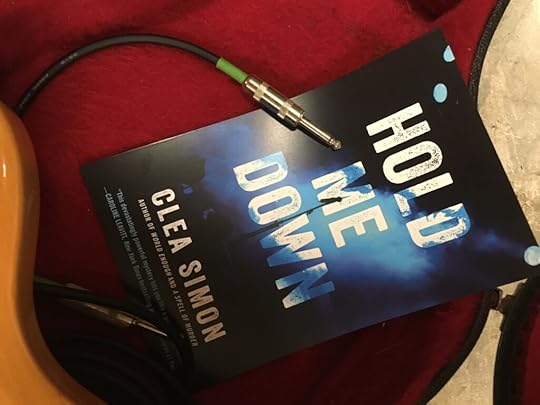
August 29, 2021
‘Shattering Glass’ wins the Anthony!
Shattering Glass, the first anthology from the groundbreaking Nasty Woman Press, has won the Anthony!
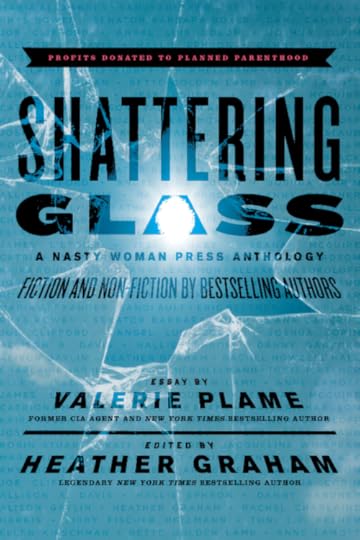
Although we couldn’t gather in person to hear the wonderful news, the awesome Bouchercon team managed a really fun virtual awards ceremony last night (thanks to the tireless tech wizardry of Erin Mitchell – see for yourself here). That meant seeing superstars like Hank Phillippi Ryan name the nominees and Lisa Unger announce the winner – and then share the moment with editor Heather Graham Pozzerese and NWP visionary Kelli Stanley, who not only named all of us contributors (thank you, Kelli!) but also spoke about the human rights mission of the nonprofit Nasty Woman Press (all proceeds from Shattering Glass go to Planned Parenthood; the next will go to the ACLU).
My story, “No Body,” was just one in this jam-packed anthology (Valerie Plame! Toni Kelner! Catriona McPherson!), but I’m as proud as can be. Thank you, Anthony voters! Thank you, Kelli for your dedication and tireless work! Thank you!
August 24, 2021
The Somerville Times takes on “Hold Me Down”
Somerville Times arts editor (and poet) Doug Holder took time to chat with me about writing, our shared city, and my upcoming Hold Me Down. I’ve pasted the Q&A below. For the full article now up on Doug’s blog, please click here. (I’ll add the Somerville Times link when that goes up!)
Your new book is a step away from your cat mysteries. What compelled you to write a mystery about a middle-aged rock star?
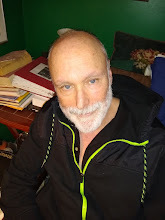 Poet/journalist Doug Holder
Poet/journalist Doug HolderI’ve always had a dark side, Doug. Even some of my cat books have been dark (“The Ninth Life,” which kicked off my Blackie and Care series, was a dystopian fantasy set in a ruined future.) But HOLD ME DOWN is really revisiting familiar ground for me. The music scene, for sure – I spent most of my 20s as a rock critic, writing for everyone from Boston Rock and Sweet Potato Magazine to the Boston Globe and Rolling Stone. But HOLD ME DOWN also mines my own past, including some trauma and the resulting PTSD that in some ways I’ve only recently come to terms with.
My 2017 mystery, “World Enough” (a Massachusetts Book Award “must read”) also took place in and around the music scene. That book dealt with the fallibility of memory, really – or how as we age we have to reevaluate our nostalgia for our youth. I guess one of my recurring themes is how we need to revisit our visions of the past and grapple with our illusions, if we’re going to grow and move on. HOLD ME DOWN certainly involves Gal, my protagonist, taking some hard looks at her past, particularly her time in the clubs leading up to her fame, and finally coming to terms with her own evasions and the half-truths she’s convinced herself are the whole story.
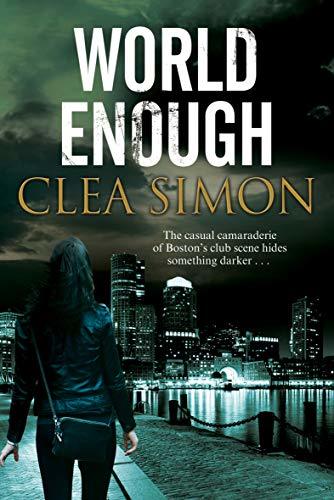
I’ve always enjoyed my cat “cozies,” as those gentle mysteries are called, and I plan on writing more. But this is a different side of me, and it needs a slightly different format – psychological suspense rather than traditional mystery. I still enjoy working within the confines of crime fiction, but a writer needs to stretch.
You started out as a rock critic–can you talk a bit about your stint? Any memorable anecdotes about the clubs, and musicians in the Boston milieu?
Sure, I loved it! The music was visceral and strong, and the scene became my tribe – where I found my people. I could tell you about hanging out with the Butler brothers of the Psychedelic Furs, or the time I got a little lost in my notes while interviewing Johnny (Rotten) Lydon, and he started teasing me, “Earth to Clea!” But what really stays with me are the shows at clubs like Jumpin’ Jack Flash, TT the Bears, the Channel, and the Rat – especially the Rat, which felt like a second home for a few years. I got the Boston Herald to let me write a local music column for a while back then, because I wanted to let the world know what was being done by innovators like the Zulus and Throwing Muses and garage rockers like the Prime Movers, the Blackjacks, and the Outlets. I met several lifelong friends there – fellow music writers like Ted Drozdowski, Brett Milano, and Paul Robicheau, and through them their partners and families – and then through them my husband Jon.
It wasn’t an easy way to earn a living. I had a succession of largely crappy part-time jobs to supplement my writing, which was largely freelance. And so when I started getting full-time journalism jobs, I cut back. Times change, and I didn’t have the energy after a while. But there’s still nothing like live music to get me going.
Is your protagonist Gal, a composite of people you knew on the scene? Was she developed with a particular person in mind?
She’s me and she’s also purely fictional in that I was never an addictive type (for which I’m grateful) and never been involved in a murder. Gal, for example, was a real rock star for a few minutes back there, even though she’s been off the road and out of the spotlight for a few years by the time of the book. I’ve played in bands, but I’ve never gone beyond the club level – and I certainly never enjoyed the stardom (or the craziness) that Gal does. For me, the idea of a performer, the tension between the private and the public self, and the dysfunctional nature of the industry were key – not that this is a book about the music industry, but it gave me a way to explore personal issues that interest me.
As far as the setup – a lot of what Gal goes through I knew just from being around music and covering the industry, radios, record labels, and the like. But to make sure I got the details right I did interview a few friends who were much more successful musicians. They provided some great anecdotes about life on the road as well as certain insights, which inform the book. For example, my buddy Lisa Susser (who sang with Vision Thing) mentioned one day about how you can see so much from the stage and so I used that – it becomes a motif, in a way, for what Gal, my protagonist sees or thinks she sees. That was just a coincidence: a fun fact that suddenly unlocked something in my protagonist’s psyche – and gave me a way to show it.
“Hold Me Down” is the title of the book, and also the title of a hit song by the protagonist.. How did you come up with this–how is it related to the theme of the book?
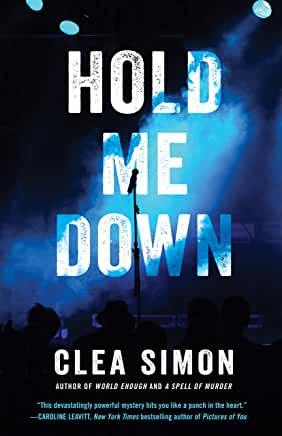
“Hold Me Down” is Gal’s big hit but it’s also her cri de coeur, her appeal to the universe. Through flashbacks we see her writing that song and learn what it means to her. It came to me like it came to her – in a flash that just felt right. Over time, I came to understand it as, I believe, does Gal.
You moved from Cambridge a few years back to Somerville. How has the writing life been in our city, compared to the Republic?
I adore Somerville! Right away, I loved the availability of city services, but I’ve also found a real community here. No offense to Cambridge – I still have great friends across Beacon Street and, really, I consider myself a citizen of Greater Camberville. But, for example, Somerville poet (and Pulitzer winning critic) Lloyd Schwartz and I are planning a joint reading event, probably for next spring. Poetry and punk-rock fiction. How cool is that?
****Simon has an event scheduled with Harvard Book Store for Oct. 28 (which will be online).
August 23, 2021
Lorie Lewis Ham on a different kind of pet
I know Lorie through her magazine,Kings River Life, which regularly publishes reviews and short fiction. I was thrilled therefore to hear that she had a new novel out – her sixth – One of Us, the first in a new series, and even more overjoyed that she wanted to share her love for a kind of pet that many of us – especially us cat people – might not expect. Take it away, Lorie!
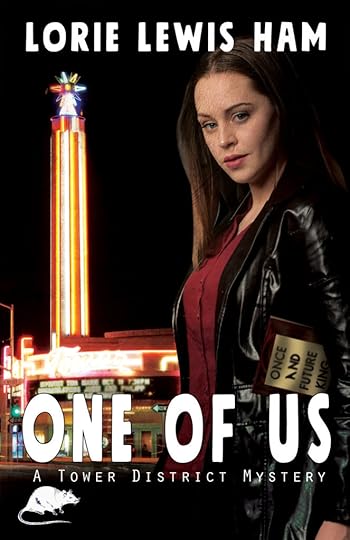
Animals have always been a great love of mine—I feel like I was born with a connection to them. I got my first dog, Max, not long after I learned how to walk, and he was my constant companion. I have been told that I also had a pet rooster that I would carry around the yard. I can’t remember a time when I didn’t have at least one pet, if not more—usually dogs.
However, when my oldest son Jay was in fourth grade I was introduced to a type of pet I never would have expected to have—a pet rat. Jay fell in love with the classroom pet rat and begged to have one of his own. I was terrified of wild mice and rats (those people you see on TV who jump on the table when they see one, that was me), but I finally gave in, with the condition that I would never have to take care of it. My husband went to the pet store and brought home a pair of rats—one tan and one black and white—they were named Buffy and Dotty. Right away, Buffy became very sick, and I was the one who had to step in and care for her. Very quickly I fell in love with these wonderful pets. Pet rats are nothing like wild ones. For one, they are smaller. They also clean themselves like cats, and can be trained to do tricks and come when they are called like dogs. They are also very affectionate. Rats come in a multitude of colors—there are even Siamese ones. There are also hairless rats, rex rats, and dumbo rats (my personal favorite).
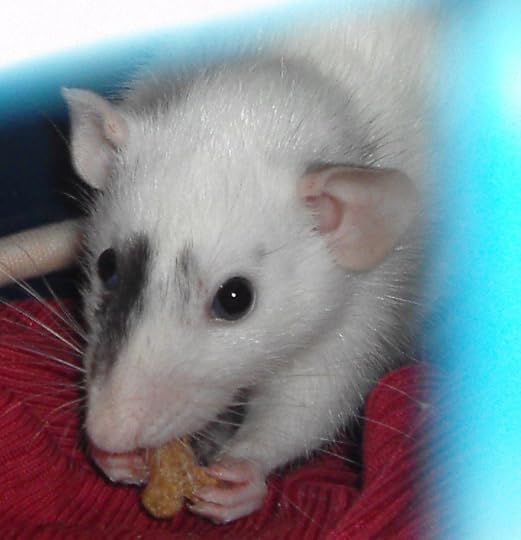
In my new mystery novel, One of Us, my main character Roxi Carlucci has a pet rat named Merlin. He is a dumbo rat. Dumbo rats have big round ears set more off to the side, and a smaller, rounder face (think Dumbo the elephant). My hope is that through getting to know Merlin more people will get to see how wonderful pet rats can be. Amazing how one encounter can change your life forever—I will always be grateful for that classroom pet who opened the door for pet rats to become a part of my life.
(You can learn more about pet rats by visiting the website of pet rat rescue Rattie Ratz. They also have a monthly column in my online magazine Kings River Life.
Other pets in One of Us include a black cat named Dan, and a pit bull named Watson. Black cats and pit bulls also suffer from unwarranted stigma—my hope is that my books will help others realize how wonderful all of these animals are.)
One of Us is available on Amazon, on the Nook at Barnes and Noble and print, and Kobo.
Lorie Lewis Ham lives in Reedley, California, and has been writing ever since she was a child. Her first song and poem were published when she was 13, and she has gone on to publish many articles, short stories, and poems throughout the years, as well as write for a local newspaper, and write six mysteries. For the past 11 years, Lorie has been the editor-in-chief and publisher of Kings River Life Magazine, and she produces Mysteryrat’s Maze Podcast where you can now hear an excerpt of her new book One of Us. You can learn more about Lorie and the new book on her website mysteryrat.comand find her on Twitter @mysteryrat and Facebook. Another way to keep up with Lorie’s writing is to subscribe to her newsletter, which you can do on her website.
Lorie has been married to Larry for 30 years and they have two grown children—Jayce and Joseph Ham. She currently has five cats (Merlin, Sam, Dean, Sidney, and Willow), four dogs (Lestat, Huey, Xander, and Phoebe), and a pet dwarf rabbit (Sherlock). For many years, she worked in pet rat rescue, and has had many pet rats of her own over the years.
August 10, 2021
Lucy Burdette’s Scottish play
I was about to congratulate noted cozy author (and past Sisters in Crime president) Lucy Burdette (aka Roberta Isleib) on her latest Key West mystery when it hit me … it’s set in Scotland? Yes, with A Scone of Contention this sweet food-oriented series is taking a trip, making for a lovely vacation when so many of us are still stuck at home. So we asked:
What is behind the pivot to Scotland?
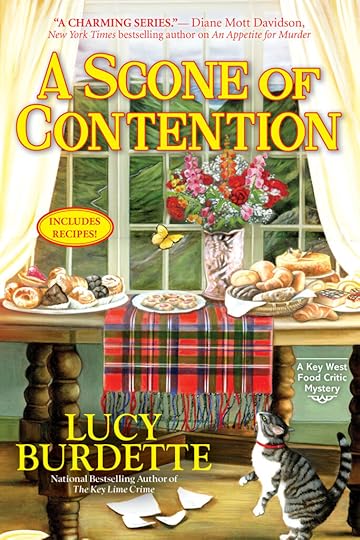
As I was thinking about how explain why I set a Key West mystery (#11, A Scone of Contention) in Scotland, I unearthed these emails that I’d written to my editor (at Crooked Lane) and my agent in August 2019.
LUCY: Having turned in book 10, I’m starting to noodle ideas on the next food critic book. I’ve set up The Key Lime Crime so that some of the characters could travel to Scotland, at least for part of the book. (This will be Hayley and Nathan’s delayed honeymoon to visit Nathan’s sister, though a few other favorite characters would horn into the trip.) Before I get too far down that road, I wanted to run the idea by you and make sure it works from your perspective. I think I could start and end the book in Key West so that familiar and expected setting would not be missing.
MATT THE EDITOR: I think that you’re going to be all right with that idea. I normally steer people towards economies of space and time (i.e. stay close to home), but now that you are 11 books deep into this series, I think you should feel free to move around a little bit. Starting and ending the book in Key West definitely helps out. It’s a smart choice.
PAIGE THE AGENT: I think Matt has already chimed in but as long as it begins and ends in Key West and a bunch of the gang is there (ie, the real community ) then it could work. There may be backlash from readers who do want that whole KEY WEST experience, but that’s okay. Another option is to just have the honeymoon take place in half the book. Just a thought!
This is me, Lucy, again. So I went ahead with the Scotland idea, as my husband John and I and a couple of my dearest friends and relations had spent two weeks in Scotland earlier that summer. I was a little stumped about what I could find new about Key West after 10 books in a row. And I suspected that this change could be good for me as a writer. And then the pandemic blanketed the world the following spring. I cannot tell you how refreshing it was to be away from that scary reality, spending time in my head back in Scotland. And I’ve been delighted to find myself full of ideas and enthusiasm as I write book #12 (back in Key West.)

I’ve heard that a few people would have preferred that my characters stay on their little island, but I sure hope on balance that most people will love the trip to Scotland. In Scone, I whittled down the travelers list to include Nathan and Hayley, Miss Gloria, and Nathan’s mother, and they are all staying with his sister and her husband. I’ve had a few complaints asking what kind of honeymoon this is? LOL! I can only say that Hayley Snow understands perfectly the meaning and importance of family.
Have you traveled with a familiar series to a new setting? How did you like the change?
New Jersey-born Lucy Burdette aka Roberta Isleib is the author of 19 mysteries, including A Scone of Contention, the latest in the Key West series featuring food critic Hayley Snow (out TODAY!). Bronze medal-winning The Key Lime Crime is the tenth book in her Key West food critic mystery series. Her books and stories have been short-listed for Agatha, Anthony, and Macavity awards. She’s a past president of Sisters in Crime, and currently serving as president of the Friends of the Key West Library.
A Scone of Contention (Book 11 in the Key West food critic mystery series)
A murderer’s out to spoil Hayley’s honeymoon in national bestselling author Lucy Burdette’s eleventh Key West Food Critic Mystery.
Key Zest food critic Hayley Snow and her groom, police detective Nathan Bransford, chose Scotland for their long-delayed honeymoon, hoping to sightsee and enjoy prize-winning scones. But their romantic duo swells to a crowd when they’re joined by Nathan’s family as well as octogenarian Miss Gloria.
Nathan’s sister Vera takes the women on a whirlwind tour of some of Scotland’s iconic mystic places as research for a looming book project. But the trip takes a deadly tartan turn when a dinner party guest falls ill and claims she was poisoned. And then the group watches in horror as a mysterious tourist tumbles to his death from the famous Falkirk Wheel, high above the Forth & Clyde canal.
Vera and her friends deny knowing the dead man, but after observing their reactions to the fall, Hayley is not convinced. With one person dead, a second possibly poisoned, and the tension among Vera’s friends as thick as farmhouse cheese, Hayley fears her long-awaited honeymoon might end with another murder.
Far away from home, surrounded by unfamiliar faces, eccentric characters, and a forbiddingly gorgeous setting, Hayley must call on all her savvy to keep a killer from striking again and then escaping Scot free.
August 6, 2021
The cost of uncertainty (a Bouchercon post-mortem)
My op-ed on Bouchercon ran in todays Boston Globe. If you can subscribe to this (or any) newspaper, I urge you to. However, I’m opting to make this readable (though it lacks some of the cool click-throughs and graphics).
OPINION
The cost of uncertaintyBouchercon was planned for Aug. 25–29 in New Orleans. Yes, New Orleans, where the number of new COVID-19 cases is breaking daily records and hospitalizations are through the roof.By Clea Simon
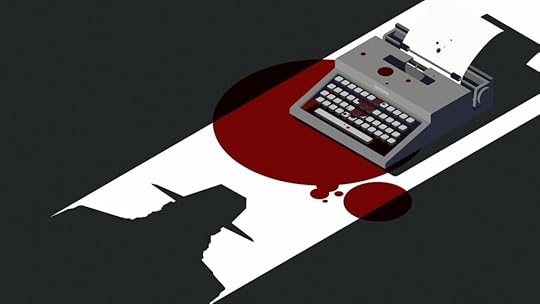
The denouement arrived by e-mail. Wednesday, midday, three weeks before it was scheduled to begin, Bouchercon was canceled.
Bouchercon is an annual crime fiction convention named for noted author and critic Anthony Boucher. Billed as “the world mystery convention,” the four-day event, which began in 1970, is volunteer run and moves to a different city each year. Oriented toward readers, it draws big names — this year’s headliner was Michael Connelly — but also mid-list authors like me who show up for a chance to be on panels, meet readers, and hang out in the bar. While attendance has topped 2,000, this year’s convention had 1,025 registered attendees at its peak, according to cochair Connie Perry. Pretty great for an event in the time of COVID-19.
The convention was planned for Aug. 25–29 in New Orleans. Yes, New Orleans, where the number of new COVID cases is breaking daily records and hospitalizations are through the roof. A few days before the official cancellation, I bowed out, as did other authors such as Sujata Massey, Shawn Cosby, and Jess Lourey. It was a huge disappointment. The hotel offered what safeguards it could, such as extra event space for social distancing. But that was all they could do. Being outdoors in NOLA in August isn’t a viable option, and an event like Bouchercon is predicated on social gathering.
This year’s Bouchercon was going to be jam-packed, with breakfast events followed by five shifts of up to seven consecutive panels at a time, interspersed with interviews with special guests, publisher-sponsored book signings, and evening festivities. To make this happen takes years of work, gearing up to 18 hours a day for the last three or four months for Perry and the other core volunteer organizers. More recently, another 10 to 15 volunteers have been assembling panels, producing two separate program books, organizing the annual “Anthony” awards, acquiring books to fill the attendees’ goodie bags as well as items for a charity auction, and myriad other tasks.
It’s a lot of effort — and a lot of money, even with all those volunteers. The 2018 Bouchercon in St. Petersburg, for example, had a budget of $370,000. But as case numbers ticked up over the last few weeks, many of us remembered what happened on March 12, 2020, when another conference, Left Coast Crime, convened in San Diego. People were still arriving or in transit as news broke that afternoon that a San Diego County public health order was going to prohibit gatherings of 250 people or more, effective at midnight. The sudden cancellation, one of many that reduced a $101 billion national convention industry in 2019 to $24 billion in 2020 (according to the Center for Exhibition Industry Research), stranded hundreds as people arrived at the San Diego airport only to board flights back home — when they could get them.
At least the county order provided some clarity. For the last few weeks, Bouchercon had been a slow-motion train wreck, with online discussions chewing over risks and responsibilities. Author Laura Lippman posted a Twitter thread detailing her concerns. While Lippman is vaccinated, she has an 11-year-old daughter who would be starting school soon after her return from the conference. Ultimately, Lippman canceled days before the organizers pulled the plug.
If there’s a silver lining to this, it’s that the parent organization, the nonprofit World Mystery Convention, has already awarded the organizers a second chance. New Orleans will host the 2025 Bouchercon, and this year’s hotel, the Marriott, is allowing the convention to transfer its bookings to 2025 and waiving penalties that would likely have topped $50,000. Add to that the outpouring of support for the organizers and I’m reminded that we are a community, writers and readers all.
Which hasn’t prevented some Monday morning quarterbacking. Could this have been prevented? Yeah, sure, if more people in America had gotten vaccinated. Predicted? I don’t think so. Which raises the next question: When can we start planning our lives again? Right now, that’s the biggest mystery of all.
Clea Simon is the author of “ Hold Me Down .” She can be reached at www.CleaSimon.com .
August 4, 2021
Sherry Harris on the bones of a good story
“A line will take us hours maybe, but if it seems more than a moment’s thought our stitching and unstitching is for naught.” William Butler Yeats was talking about poetry, but he may as well have been talking about cozies. These fun character-driven mysteries need to come across as frothy and light – and only those of us who have been there understand just how hard the author works to maintain this illusion. As the wonderful and talented Sherry Harris knows, serendipity can sometimes play a part. As she welcomes A Time to Swill, the followup to From Beer to Eternity, that bit of inspiration came from a supporting character – or, more accurately, his first wife, whom he had declared dead…
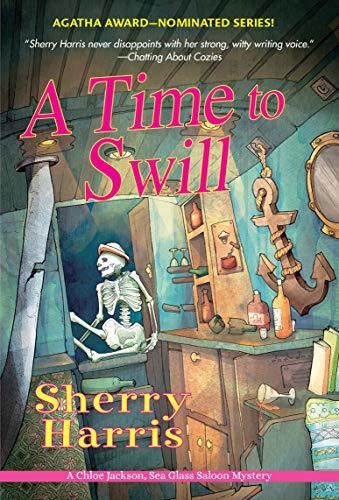
When A Line of No Importance Becomes Important
So much of the writing process is mystical to me. From the where do ideas come from to why I give characters certain traits. That really played out when I was writing A Time to Swill, the second Chloe Jackson Sea Glass Saloon mystery and Three Shots to the Wind, the third book in the series.
One of the side characters in From Beer to Eternity is Ralph Harrison. He’s married to his high school sweetheart and although they are in their early seventies, they have only been married a few years. Because of racial prejudices in the sixties their parents made them break up. Both went on to marry other people. In From Beer to Eternity, I mention that Ralph’s first wife had disappeared twelve years earlier and that Ralph had her declared legally dead.
When I wrote that, I wasn’t thinking “I’m going to explore that in the next book.” I just dropped in it there for some reason. However, when I started writing A Time to Swill, I have Chloe board an abandoned ship (for a very good reason) that gets swept back out to sea. While Chloe is onboard, she finds a skeleton. Once back on shore it becomes clear that the skeleton and other evidence on the boat points to Ralph’s missing wife. That sets Chloe on a journey even more unexpected than getting swept out to sea.

I don’t write huge character sketches about my main characters before I start writing. I knew a few things about Chloe before I set out writing the first book From Beer to Eternity. Chloe was twenty-eight, she was from Chicago, was a children’s librarian, she ran almost every day, and she had a tragic event occur when she was ten that still was impacting her life. With those things in mind, I started writing the first book. As I went along, I wrote that she had an ex-fiancée. He was a nice but somewhat dull man. That’s all I said about him. He’s also mentioned in A Time to Swill but doesn’t even have a name.
However, when I was writing the third book, Three Shots to the Wind, I started toying with the idea that ex-fiancée Perry Franklin (yes, he gets a name) shows up in Emerald Cove to try to win Chloe back with disastrous results. Chloe soon finds out that the man she dismissed as dull wasn’t who she thought he was and as the story unfolds it’s one shock after another for Chloe.
Maybe my subconscious is working on things without me realizing it. Ah, that is the magic of writing. I love when some tiny little grain of an idea or in this case a line, turns into something much bigger.
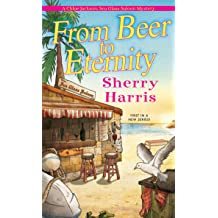
Sherry Harris is the Agatha Award nominated author of the Sarah Winston Garage Sale mystery series and the Chloe Jackson Sea Glass Saloon mysteries. Sherry is a past president of Sisters in Crime, a member of the Chesapeake Chapter of Sisters in Crime, the New England Chapter of Sisters in Crime and Mystery Writers of America. Sherry loves books, beaches, bars, and Westies — not necessarily in that order. She is also a patent holding inventor. Sherry blogs with Wicked Cozies at https://wickedauthors.com/ Find her on Twitter – Sharrisauthor , Facebook: https://www.facebook.com/SherryHarrisauthor , and Instagram at SherryHarrisAuthor
August 2, 2021
INCANTATION works its magic
Just got a bit of happy news: AN INCANTATION OF CATS was awarded a certificate of excellence by the Cat Writers’ Association in this international group’s 2020 communications contest.
Thank you!
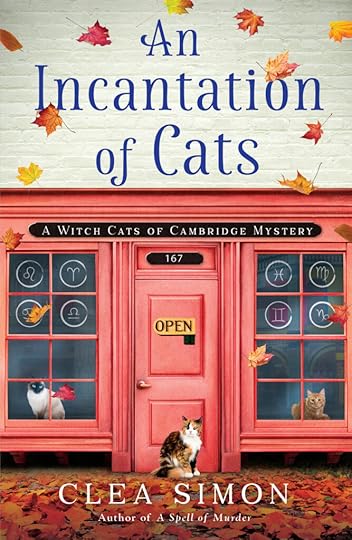
July 26, 2021
Ang Pompano: Dieting can be deadly…
Congratulations to Ang Pompano, whose new Diet of Death came out last month. This fun and fast-paced amateur sleuth is the first in the “Cooking with Betty” series. But readers might recognize a familiar face…

This isn’t your protagonist Quincy Lazarro’s first outing, is that right?
Yes, there were several Quincy stories in the past, starting with “The Copycat Didn’t Have Nine Lives,” back in 2007. Quincy and I share a bond. He’s the brother I never had. We are very much alike so he’s my go-to character when I write because I’ve built up a little world called Sachem Creek where Quincy resides.
Diet of Death, your second full-length novel, is quite a departure from your Agatha-nominated debut When It’s Time For Leaving. Would you tell us about your journey? What happened? What changed?
What happened was that “virus that shall not be named.” I was working on a sequel to WHEN IT’S TIME FOR LEAVING called RIDERS ON THE STORM. As was the first book, it’s a traditional mystery about a retired police detective whose father comes back into his life after twenty-eight years. The father is in the early stages of dementia and gives the son his detective agency. But there are strings attached the size of ropes.
I think a lot of us hit a slump during the pandemic. We had the time to write but not the heart. RIDERS was coming along slowly, when my wife, Annette, suggested that I turn my story “Diet of Death” into a novel. The story had appeared in PARNELL HALL PRESENTS MALICE DOMESTIC MYSTERY MOST EDIBLE. The anthology had won an Anthony Award and I was so honored to be included in the lineup.
The DIET OF DEATH starts the same as the story but has a completely different plot. I needed to write something light and humorous so I ended up with my version of a culinary mystery. It’s about Quincy Lazzaro who is tricked into writing a food column. He doesn’t know much about food but with the help of his feisty octogenarian neighbor, Mary, the column is a hit and he’s trapped in the job. When an interview with a Diet Guru results in murder Mary uses her Miss Marple-like ability to use observations of everyday situations to encourage Quincy to solve the crime. I do plan to get back to RIDERS but I have a sequel to DIET OF DEATH called INGREDIENTS OF DEATH to finish first.
Do you think about your reader when you write? Do you see your works as appealing to different types of readers?
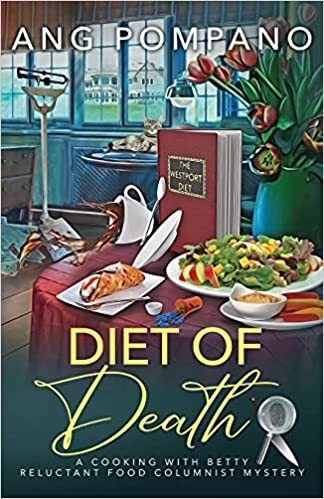
I always keep my reader in mind in the respect that I’d never want to write something that offended someone or made them feel bad. I think I share many values with my audience so it’s not that difficult.
On the other hand, I write what I’d like to read. DIET OF DEATH is similar in some ways and quite different in others from WHEN IT’S TIME FOR LEAVING. I remember an interviewer asking Paul McCartney why the Beatles changed their style that was obviously working. His answer was something to the effect of “I didn’t want to keep recording the son of Love Me Do.
I expect some people to compare this book to the last. Some will welcome the change others may not. But that’s okay.
You’ve made a name for yourself with your short stories. What prompted you to tackle novels? Is the process different for you?
I always wanted to publish a novel and I’ve written a few of them going back to the 1980s. They are mercifully living on floppy disks that I can no longer access. It’s not that the world wasn’t ready for them. They weren’t ready for the world. It takes practice to learn this craft and nobody ever accused me of being a fast learner.
Then too, I’ve been in a writing group with Roberta Isleib (Lucy Burdette), and Chris Falcone for more than twenty years. Lucy, of course, writes the best-selling Key West Food Critic Mysteries and Chris writes amazing short stories and is about to publish a novel. Since I always had a novel in mind I decided to jump on the bandwagon. They’ve both been great inspirations and have taught me so much.
As for the process, if a short story isn’t working, it can be just as difficult to write as a novel. I was writing a story for the upcoming BEST NEW ENGLAND CRIME STORIES: BLOODROOT that Susan Oleksiw, Leslie Wheeler, and I are putting together. (Yes, we have to submit and be accepted too.) I loved the theme and the characters, but I wasn’t relating to the story, or I wasn’t ready to write it. Whatever. So I wrote something else that I was very pleased with. At some point, I’ll be ready to write the other story and it will flow. By the way, I’m so happy that your story “No Cities to Live” will be in BLOODROOT. It’s a wonderful story.
Thank you, Ang! I’m honored to be included! But back to Diet of Death – the book starts with an amateur sleuth who is writing a cooking column under a pseudonym. Where did that come from?
I think a lot of us stick with a job that we like (or don’t) because we have obligations, but it’s not their dream job. I wanted to take that to the next step so I have Quincy tricked into writing a cooking column on the promise that he will get an investigative reporting job in the future. The fact that he has to hide the fact that he’s the nonexistent “Betty” is a classic theme of gender stereotypes and male/female interpersonal relationships that has been around since Shakespeare.
Your setup is so fast and delivers so many suspects in very few pages. Would you talk a little about pacing?
I like to start with the murder right away. Sometimes in the first sentence, but if not, in the first or second chapter. And I want to give my readers something to think about early on. I’m a Beatles fan. Sometimes I want to hear something fast like Helter Skelter or “Back in the USSR at other times I feel like listening to something slower like Hey Jude or Yesterday. It’s the same thing with reading. At times you want something fast-paced and at others you want might want something slower-paced. DIET OF DEATH is meant to be a lighthearted take on a culinary mystery. I’d like people to read itfor fun, although there are some deeper themes such as living up to the accomplishments of a sibling that died before you were born. But all of that came out later and in bits and pieces. I wanted the reader to know from the first chapter that this was going to be fun. Let’s help this guy who is stuck in a ridiculous job situation solve a murder. There are some whacky characters in that chapter who have interactions with the Diet Doctor. Then in the second chapter, the Diet Guru is dead. Did one of those characters who have a pretty good motive do it? Of course, I didn’t want to exhaust the reader, so I used interior monologue where Quincy reflected on what he had observed up to that point, debated on what his next course of action should be, and even question if he was doing the right thing, to slow it down a bit.
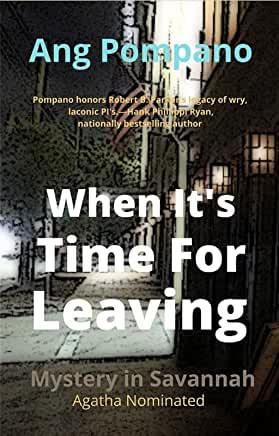
My first book, WHEN IT’S TIME FOR LEAVING, while having some humor, dealt with serious issues such as abandonment, reconciliation, making up for lost time, and duty. It also dealt with some pretty heavy stuff such as dementia. So I had to spend the first chapter getting the reader to understand what life up to that point had been like for Al, the protagonist. If not they might not like him. Quincy, I think, is pretty likable from the beginning. But even in the first book, the murder happened in the second chapter. The reader is there to help solve a murder so I try to give them what they want fairly early.
You doff your cap to the real-life murder of Scarsdale Diet doctor Herman Tarnower. Did that case play a role in your writing?
Yes, the murder of Herman Tarnower always interested me so I mentioned him in the book. Both he and Carlton Fredericks, a commentator and writer on health and nutrition, were probably in the back of my mind when I created the fictional Dr. Tolzer. I’m interested in holistic medicine and I’d rather eat my nutrients than taking pills. Carlton Fredricks was talking about bioflavonoids and anti-oxidants thirty years before the mainstream medical community. I always listened to his radio show until one day they announced that he was dead. There he was telling everyone how to live a healthy life and he died at a fairly early age. It made me wonder what if… And you know what happens when a mystery writer wonders that. It results in a book.
What writers have you learned from – and can you share any specifics?
I learn something from every book I read. There are some books I read over and over, not only because I like them but to study technique. For example, I read THE OLD MAN AND THE SEA and THE GREAT GATSBY every summer and I learn something every time. But if you’re looking for books that teach character, dialogue, setting, theme, plot, and conflict you can’t go wrong with books by our friends Hallie Ephron (Writing and Selling Your Mystery Novel Revised and Expanded) and Paula Munier (Plot Perfect.)
What’s next?
The BLOODROOT anthology is coming in November. And I’m almost finished with INGREDIENTS OF MURDER. then it’s back to RIDERS ON THE STORM. After that, I wouldn’t be surprised if I do a children’s book with illustrations by Annette. I’ve been at this too long to stop now.
Ang Pompano’s short stories have appeared in many anthologies, including the Anthony winning, Malice Domestic: Mystery Most Edible. His first novel When It’s Time for Leaving, was nominated for an Agatha Best First Novel Award. His second novel, Diet of Death was published in June, 2021. A member of Mystery Writers of America, he was a awarded a Helen McCloy/MWA scholarship for a novel in progress. He served for many years as a board member of Sisters in Crime New England and has been on the New England Crime Bake Committee for fifteen years. He is the co-founder and editor of Crime Spell Books. He lives in Connecticut with his wife, Annette, and their two rescue dogs.



